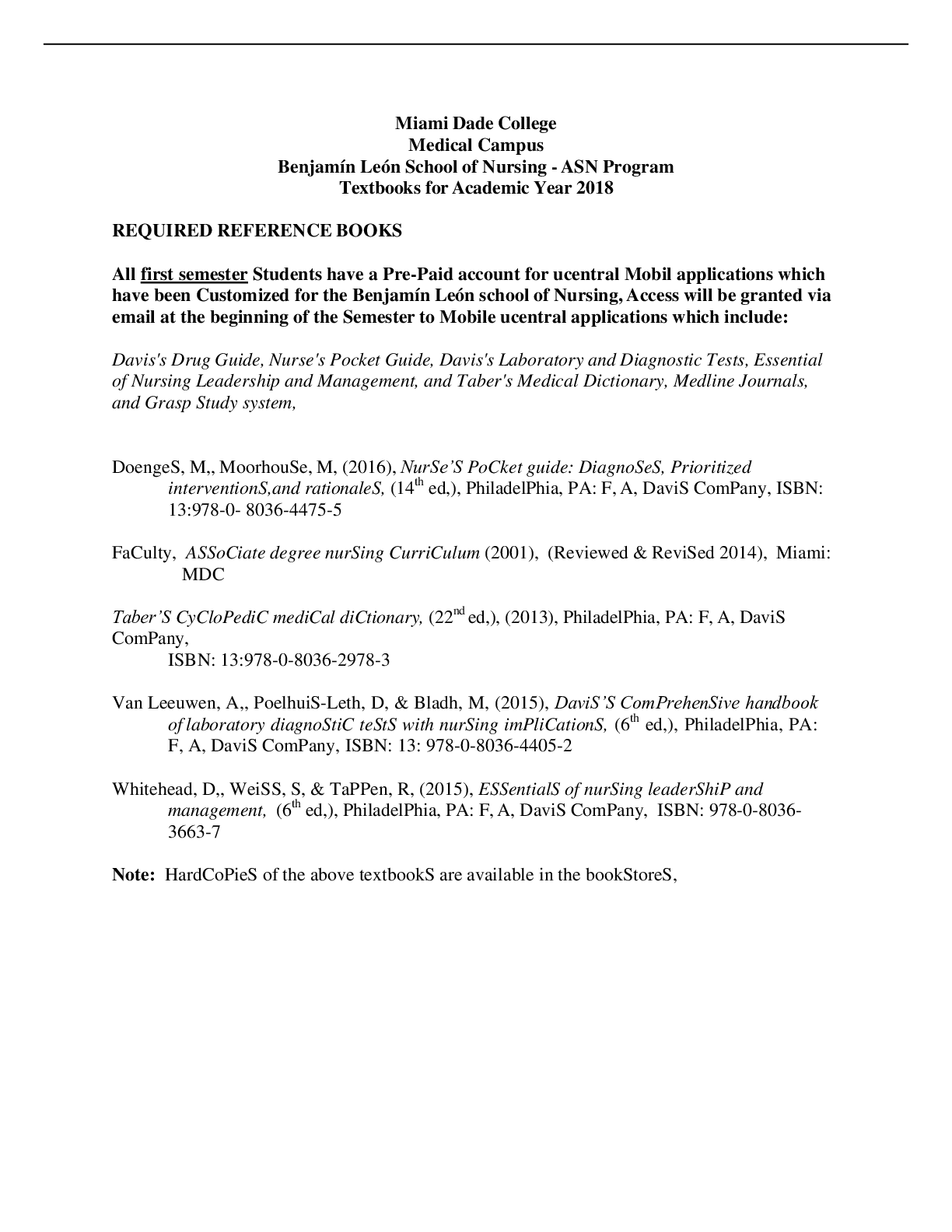*NURSING > TEST BANK > Chamberlain College of Nursing - NURSING NR 283 PATHO TEST BANK 2_100% WORKING (All)
Chamberlain College of Nursing - NURSING NR 283 PATHO TEST BANK 2_100% WORKING
Document Content and Description Below
Chapter 4 Pain 1. The impulses related to acute pain are usually transmitted by: a. nociceptors. b. myelinated A delta fibers. c. unmyelinated C fibers. d. any sensory fiber with a low pain thres... hold. ANS: B REF: 55 2. In which structure do pain impulses ascend the spinal cord? a. Reticular formation b. Corticospinal tract c. Spinothalamic tract d. Relevant dermatome ANS: C REF: 55 3. According to the gatecontrol theory, passage of pain impulses may be naturally blocked: a. at the synapse by entry of other sensory impulses. b. by the stress response. c. by administration of morphine directly into the spinal cord. d. by referring the pain to other parts of the body. ANS: A REF: 55 4. What is the term used to describe the degree of pain that is endured before an individual takes action? a. Pain threshold b. Referred pain c. Phantom pain d. Pain tolerance ANS: D REF: 55 5. What is the definition of endorphins? a. Neurotransmitters at the nociceptors b. Transmitters for sensory impulses c. Opiatelike blocking agents in the central nervous system d. Paincausing chemical mediators ANS: C REF: 57 6. Pain perceived in the left arm during the course of a heart attack is an example of: a. referred pain. b. phantom pain. c. chronic pain. d. subjective pain response. ANS: A REF: 57 7. A headache that is related to changes in cerebral blood flow is classified as a/an ________ headache. a. tension b. sinus c. migraine d. intracranial ANS: C REF: 60 8. What is a common analgesic administered to control a moderate level of pain? a. Meperidine b. Acetaminophen c. Codeine d. Ibuprofen ANS: C REF: 62 9. Which of the following applies to spinal anesthesia? a. It causes analgesia with loss of consciousness. b. The drug is injected into cerebrospinal fluid (CSF) or the epidural space of the spinal cord. c. The drug stimulates release of endorphins in the spinal cord. d. The transmission of pain impulses is blocked in a small area of the body. ANS: B REF: 62 10. Which of the following is a characteristic of acute pain but not of chronic pain? a. Depression and debilitation b. A perception of increased generalized pain and discomfort c. Fatigue and lower pain tolerance d. Severe but short term ANS: D REF: 5557 11. What is the role of nociceptors? They are: a. pain receptors that are stimulated by thermal, chemical, or physical means. b. spinal nerves that conduct impulses from specific areas of the skin. c. responsible for the state of arousal with pain. d. useful in localizing pain to a specific area of the body. ANS: A REF: 54 12. Intractable pain is best defined as: a. pain that is perceived as occurring in an amputated limb. b. severe pain that cannot be controlled by medication. c. pain perceived as coming from a source other than the actual source. d. pain coming from a specific dermatome. ANS: B REF: 62 13. Which of the following statements is TRUE? a. The brain is more aware of pain impulses when the reticular activating system is depressed. b. Acute pain does not cause a reflex response at the spinal cord synapses. c. Young infants typically respond to pain with tachycardia and increased blood pressure. d. Chronic pain is easier to tolerate without negative effects. ANS: C REF: 57 14. Ibuprofen is classified as an NSAID and is particularly useful in treating: a. severe pain. b. pain caused by inflammation. c. intracranial pain. d. pain in young infants. ANS: B REF: 61 15. Which of the following analgesics acts to reduce pain at the peripheral site? a. Acetaminophen b. Morphine c. Codeine d. Intravenous general anesthesia ANS: A REF: 61 16. Cancerrelated pain has been broken down into three basic categories: pain caused by the advance of the disease and resultant damage to the body, pain that is the result of a coexisting disease unrelated to the cancer, and: a. phantom pain as a result of amputation. b. pain associated with the treatment of the disease. c. pain caused by emotional stress and metabolic changes. d. pain associated with damage to the peripheral nerves. ANS: B REF: 61 17. Pain that is caused by trauma or disease involving the peripheral nerves is referred to as: a. neuropathic pain. b. central pain. c. neurogenic pain. d. referred pain. ANS: A REF: 61 18. Pain resulting from a profound, sudden loss of blood flow to an organ or tissues in a specific area of the body is referred to as: a. chronic pain. b. central pain. c. cardiovascular pain. d. ischemic pain. ANS: D REF: 61 19. Which of the following is a characteristic of chronic pain? a. It usually initiates a physiological stress response. b. It always involves a strong emotional response such as high anxiety. c. It is more difficult to diagnose and treat than is acute pain. d. It involves tissue damage to a specific organ. ANS: C REF: 59 | 60 20. A headache that results from pressure on the meninges surrounding the brain is referred to as a/an: a. intracranial headache. b. intrameningeal headache. c. migraine headache. d. cerebral headache. ANS: A REF: 60 Chapter 14: Neurological Disorders 1. Through what area does the cerebrospinal fluid circulate around the brain and spinal cord? a. Between the double layers of the dura mater b. In the subdural space c. In the subarachnoid space d. Through the arachnoid villi ANS: C REF: 327 2. Which of the following is the usual location of language centers? a. Left hemisphere b. Right hemisphere c. Brainstem d. Hypothalamus ANS: A REF: 329 3. What would be the effect of damage to the auditory association area in the left hemisphere? a. Loss of hearing in both ears b. Inability to understand what is heard c. Loss of hearing in the left ear d. Inability to determine the source of the sound ANS: B REF: 329 4. Which of the following applies to the corticospinal tract? a. It is an ascending tract. b. The nerve fibers conduct sensory impulses. c. It is an extrapyramidal tract. d. It is a pyramidal tract for efferent impulses. ANS: D REF REF: 332 5. What is a major function of the limbic system? a. Overall control of fluid balance b. Required for logical thinking, reason, and decision making c. Determines emotional responses d. Responsible for artistic and musical talents ANS: C REF: 330 6. Where are β1adrenergic receptors located? a. Bronchiolar walls b. Arteriolar walls c. Cardiac muscle d. Glands of the intestinal tract ANS: C REF: 337 7. What does a vegetative state refer to? a. Depression of the reticular activating system (RAS) and inability to initiate action b. Loss of awareness and intellectual function but continued brainstem function c. Continuing intellectual function but inability to communicate or move d. Disorientation and confusion with decreased responsiveness ANS: B REF: 338339 8. Which of the following conditions is NOT part of the criteria for a declaration of “brain death”? a. No activity on EEG b. Absence of all reflexes c. No spontaneous respirations d. Presence of any head injury ANS: D REF: 339 9. What is the best definition of aphasia? a. The inability to comprehend or express language appropriately b. Difficulty swallowing c. Loss of the visual field contralateral to the area of damage d. The inability to articulate words clearly ANS: A REF: 340 10. What is an early indicator of increased intracranial pressure? a. Papilledema b. Bilateral fixed dilated pupils c. Decreasing responsiveness d. Rapid heart rate ANS: C REF: 342 11. What is the rationale for vomiting in a patient who has increased intracranial pressure? a. Chemoreceptors responding to changes in the blood b. Pressure extending to spinal nerves c. Pressure on the emetic center in the medulla d. Stimuli to the hypothalamic center for hunger and thirst ANS: C REF: 342 12. What is the typical change in blood pressure in a patient who has increased intracranial pressure? a. Erratic diastolic pressure b. Decreasing systolic pressure c. Systolic and diastolic pressures decreasing proportionately d. Increasing pulse pressure ANS: D REF: 342 13. The largest category of primary malignant brain tumors that arise from cells in the central nervous system (CNS) are called: a. gliomas. b. sarcomas. c. lymphomas. d. myelomas. ANS: A REF: 345 14. Which of the following causes papilledema? a. Increased pressure of cerebrospinal fluid (CSF) at the optic disc b. Increased intraocular pressure c. Pressure on the oculomotor nerve d. Pressure on the optic chiasm ANS: A REF: 342 15. What is the effect of an enlarging brain abscess on cardiovascular activity? a. Increased heart rate and systemic vasodilation b. Low blood pressure and irregular heart and respiratory rates c. Systemic vasoconstriction and slower heart rate d. Immediate depression of the cardiac control centers ANS: C REF: 342 16. As intracranial pressure rises, the pupil of the eye, ipsilateral to the lesion, becomes dilated and unresponsive to light because of pressure on the: a. optic nerve. b. peripheral nervous system (PNS) fibers in cranial nerve III. c. sympathetic nervous system (SNS) nerve to the eye. d. occipital lobe. ANS: B REF: 342 17. Which of the following characteristics indicates that the CSF is normal? a. Cloudy and pale yellow color b. Presence of erythrocytes c. Presence of numerous leukocytes d. Clear and colorless fluid ANS: D REF: 327 18. Which of the following statements is TRUE about malignant brain tumors? a. Most brain tumors arise from malignant neurons. b. Primary brain tumors rarely metastasize outside the CNS. c. The bloodbrain barrier prevents secondary brain tumors. d. Brainstem tumors do not manifest signs until they are quite large. ANS: B REF: 345 [Show More]
Last updated: 11 months ago
Preview 1 out of 60 pages

Reviews( 0 )
Document information
Connected school, study & course
About the document
Uploaded On
Sep 19, 2021
Number of pages
60
Written in
Additional information
This document has been written for:
Uploaded
Sep 19, 2021
Downloads
0
Views
40



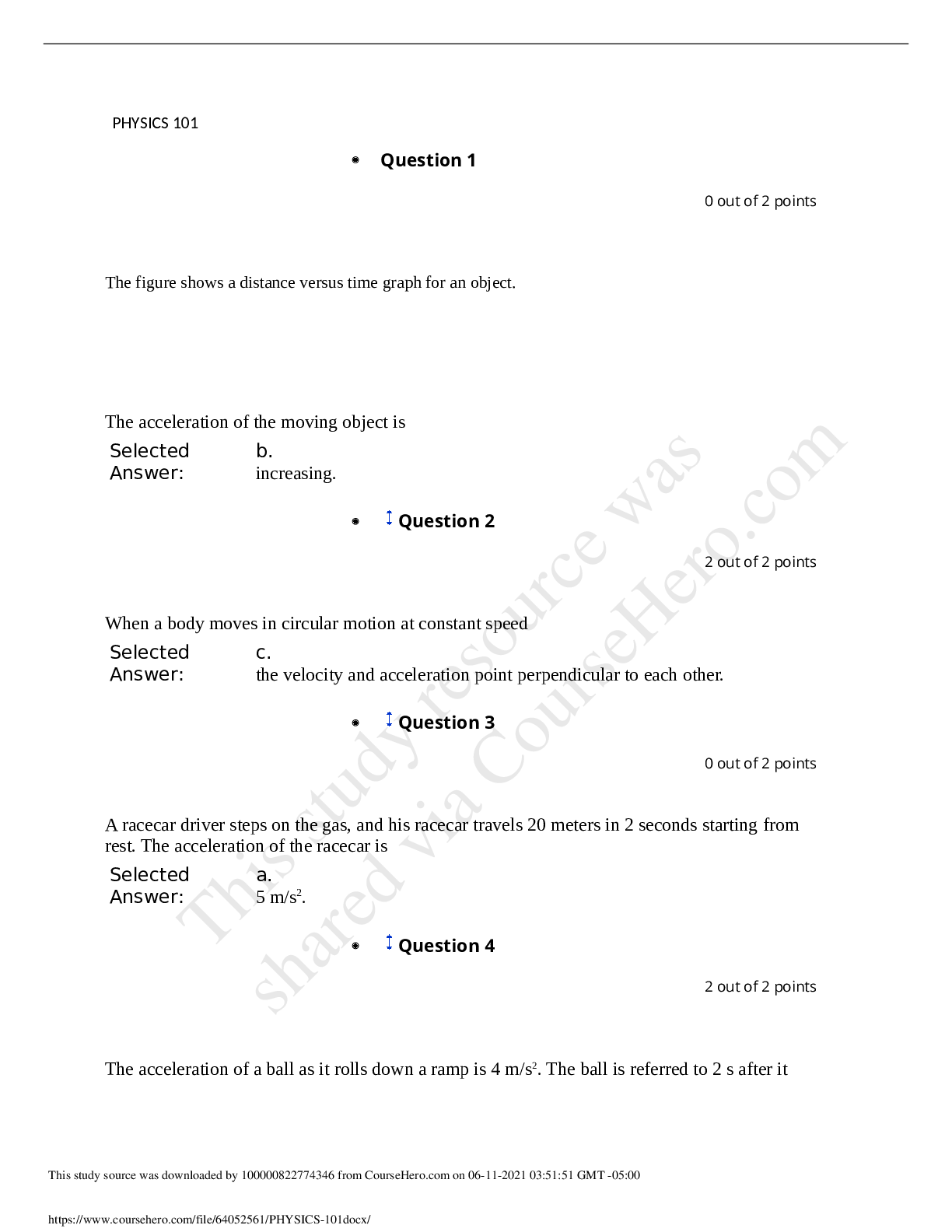
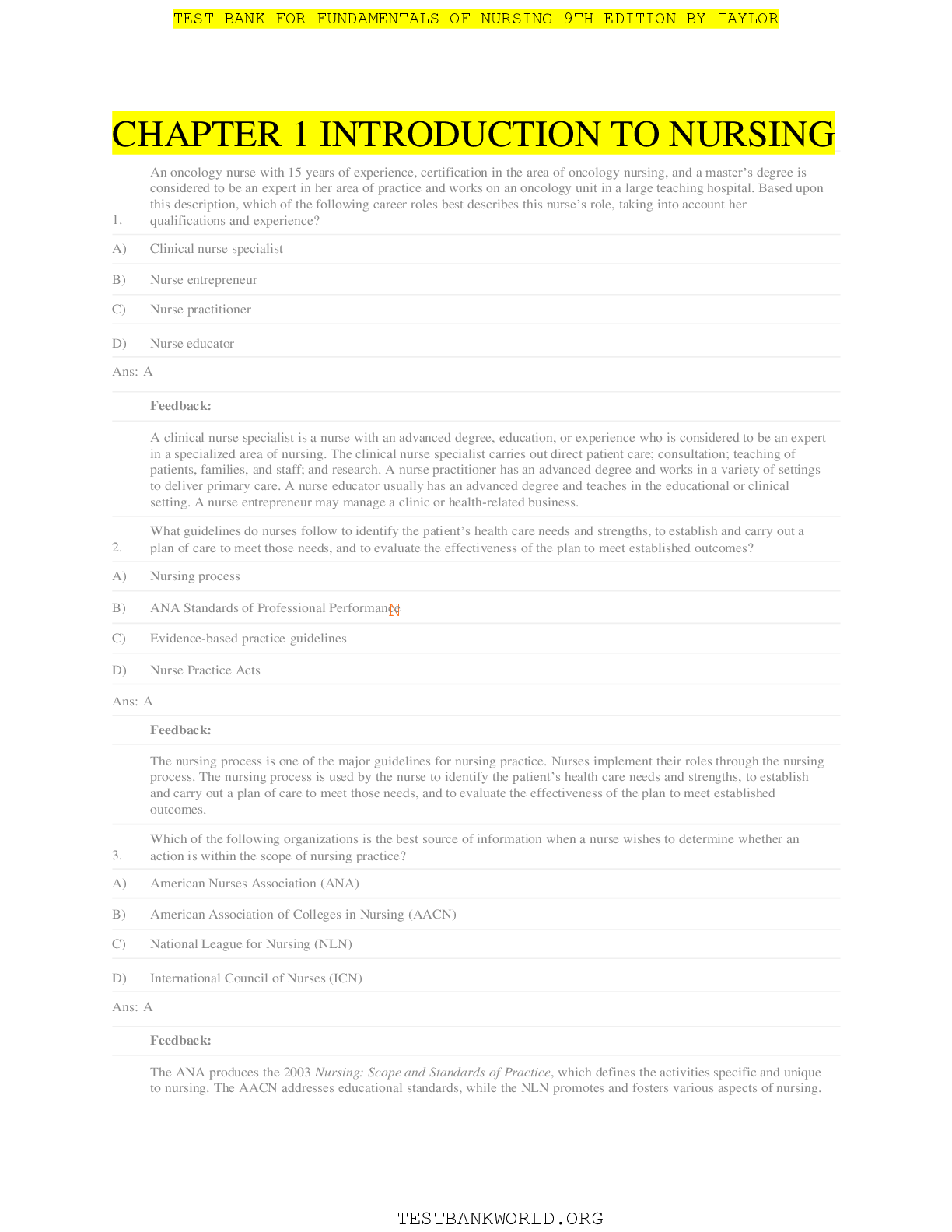

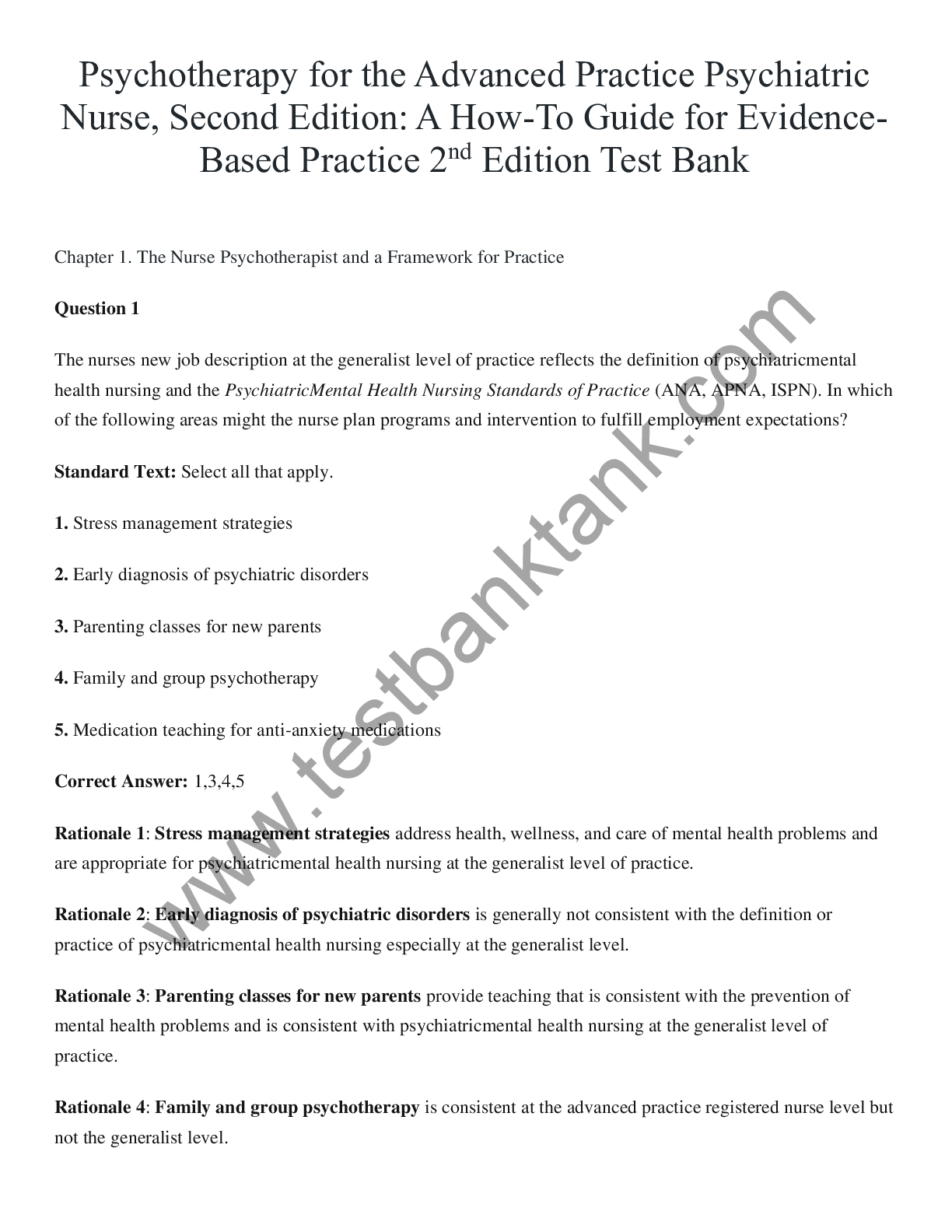

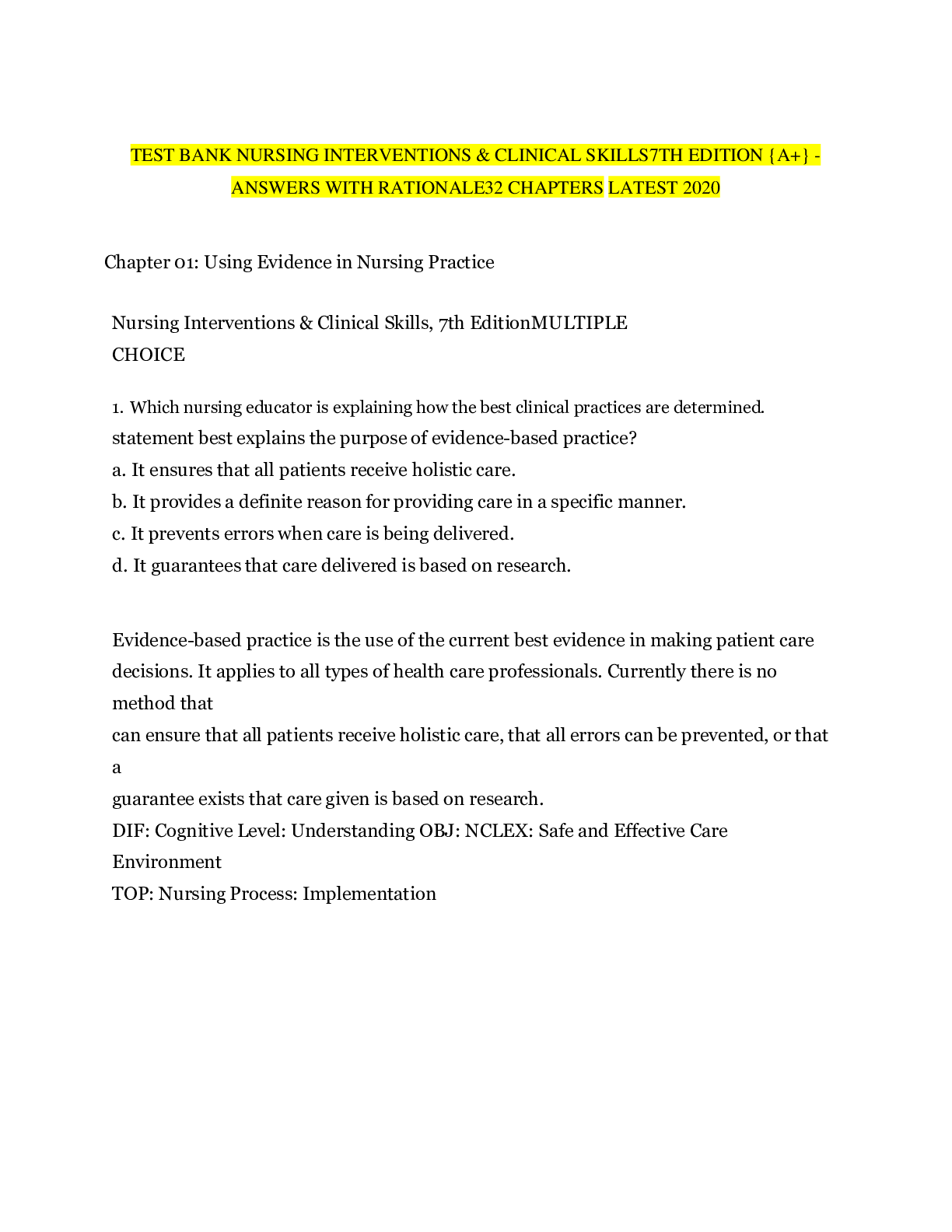
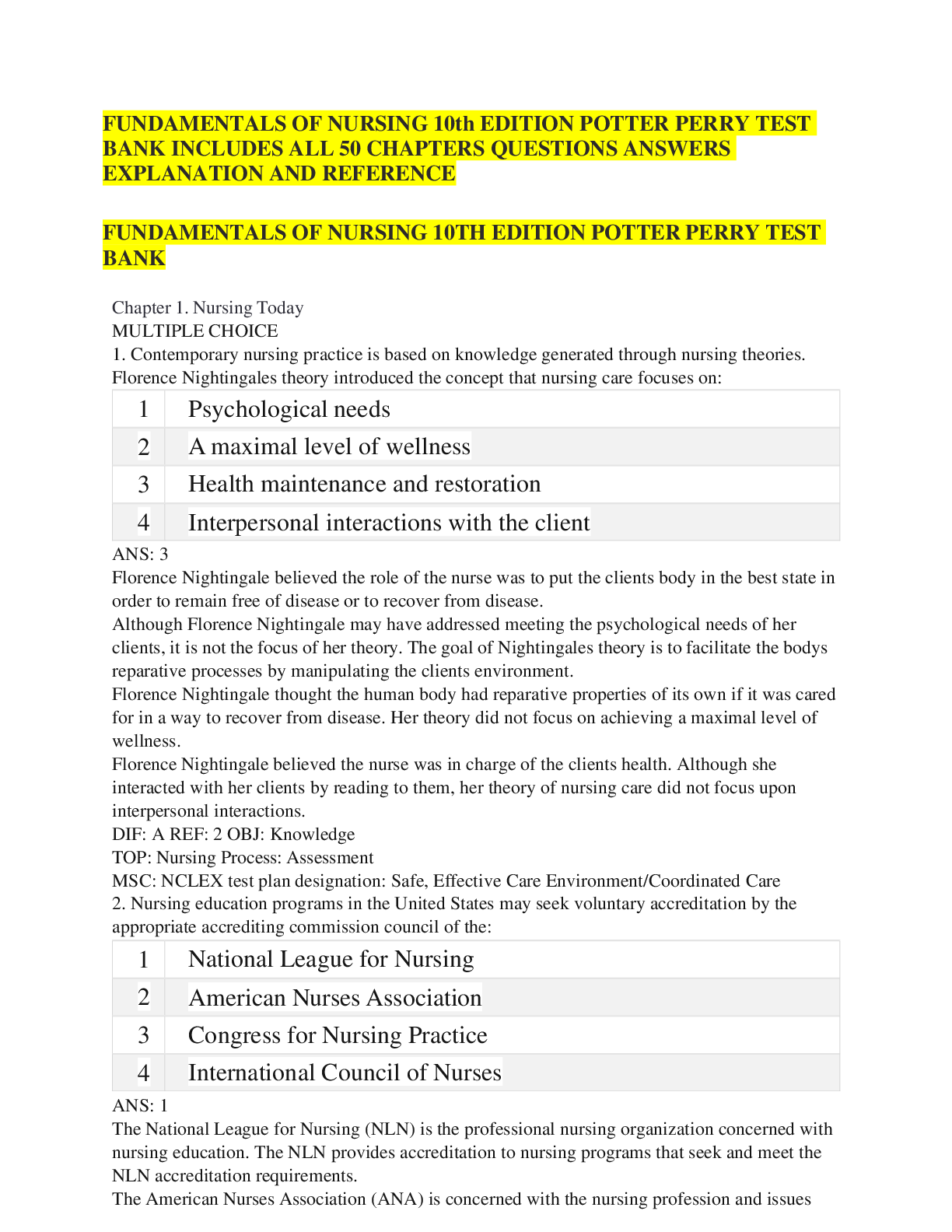

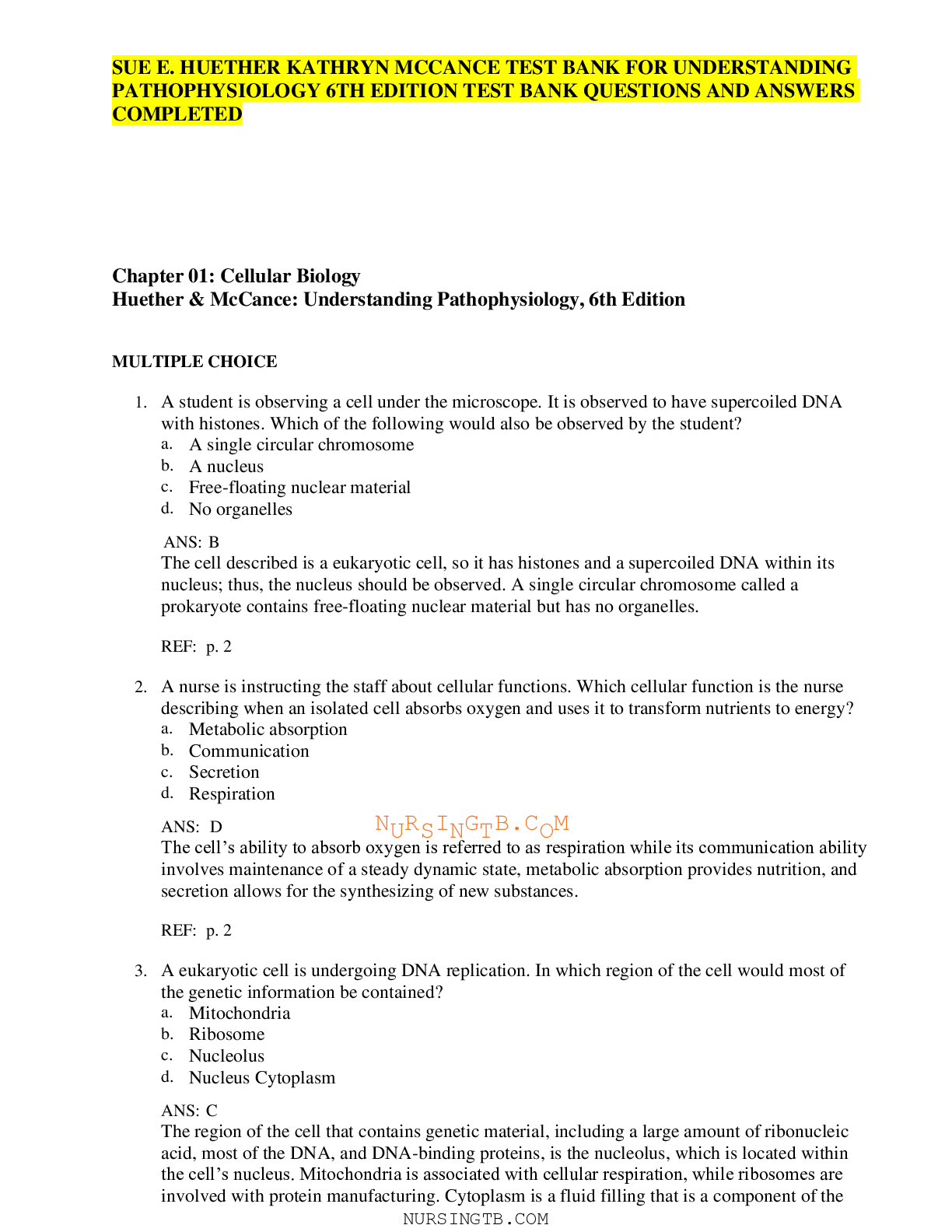
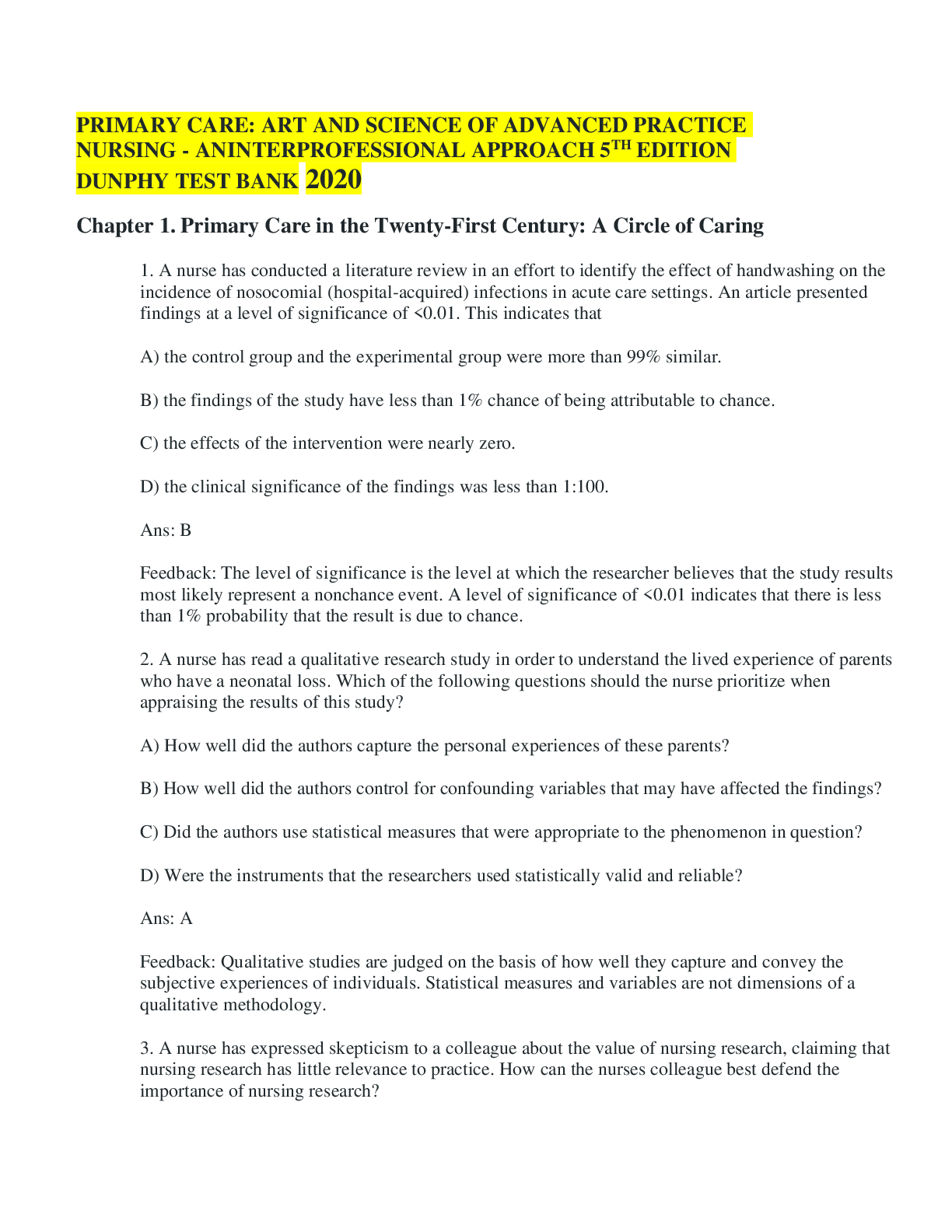

-2021 (1).png)
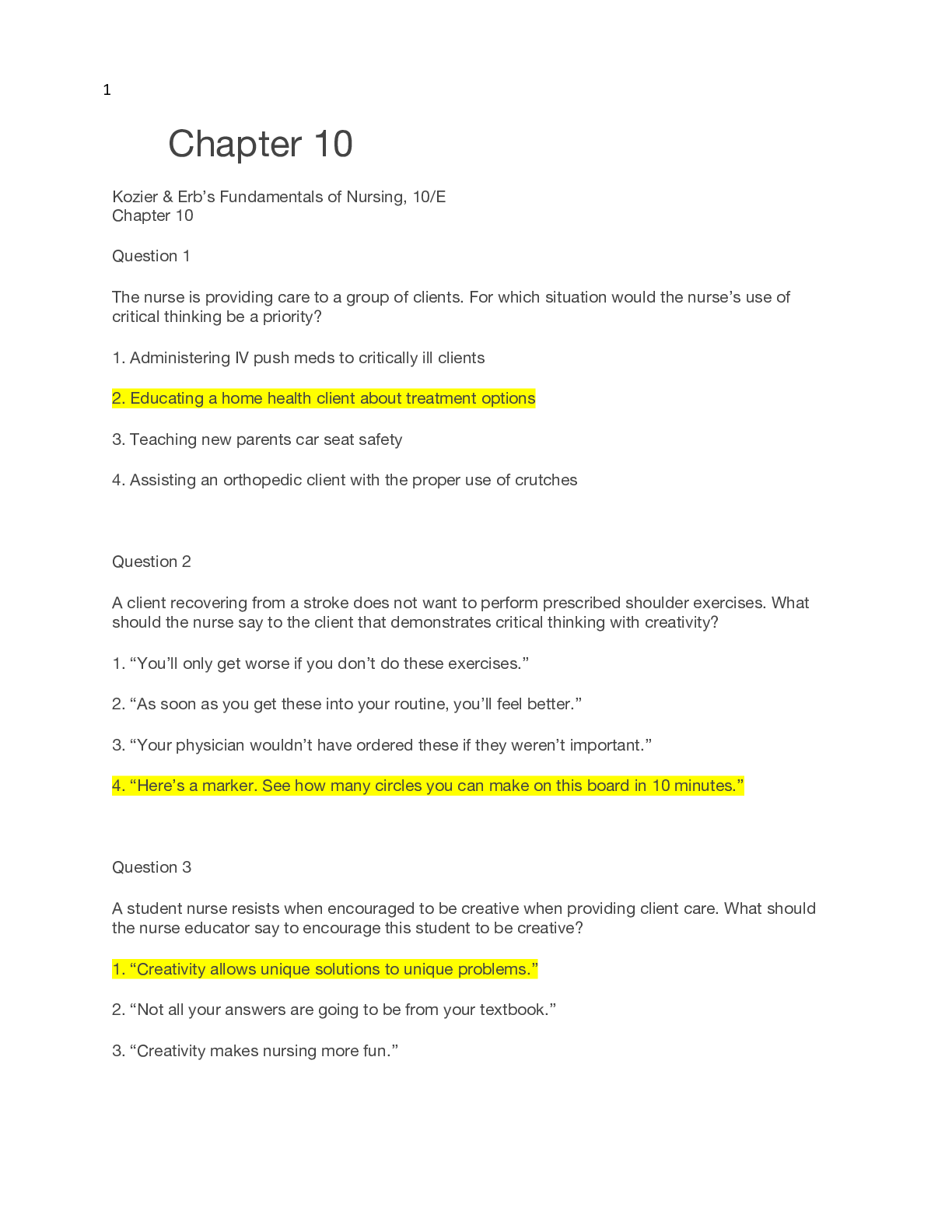
-2021.png)
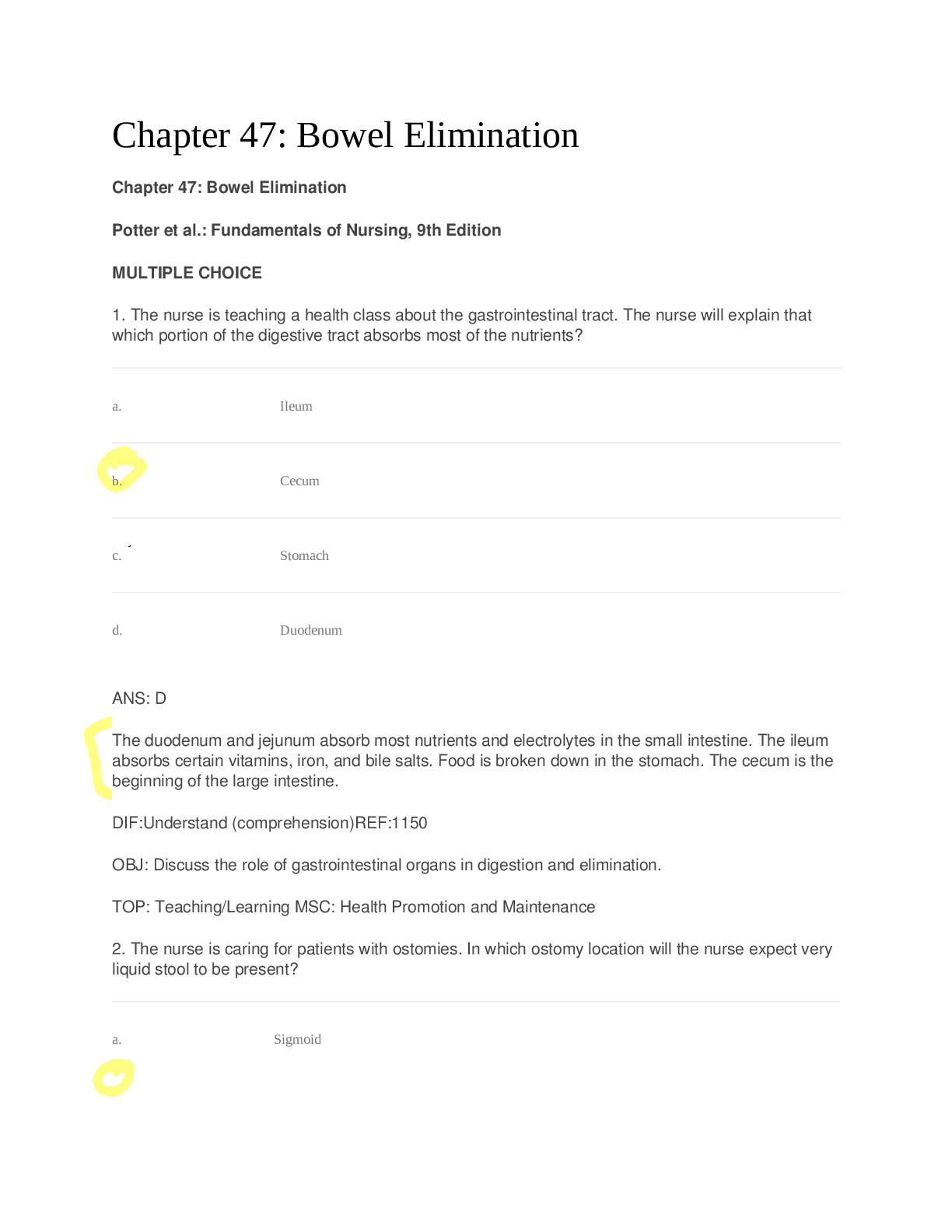
.png)
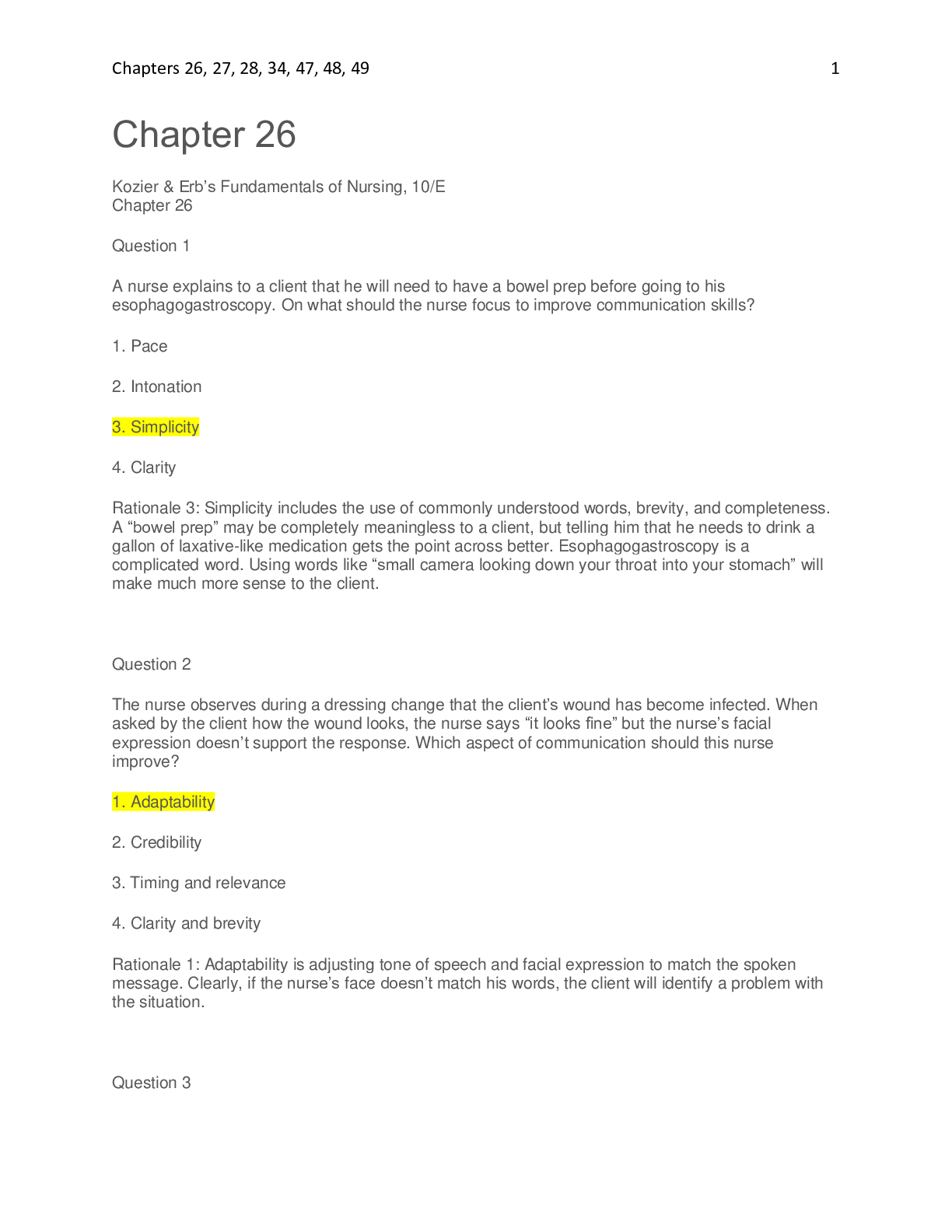


.png)
.png)


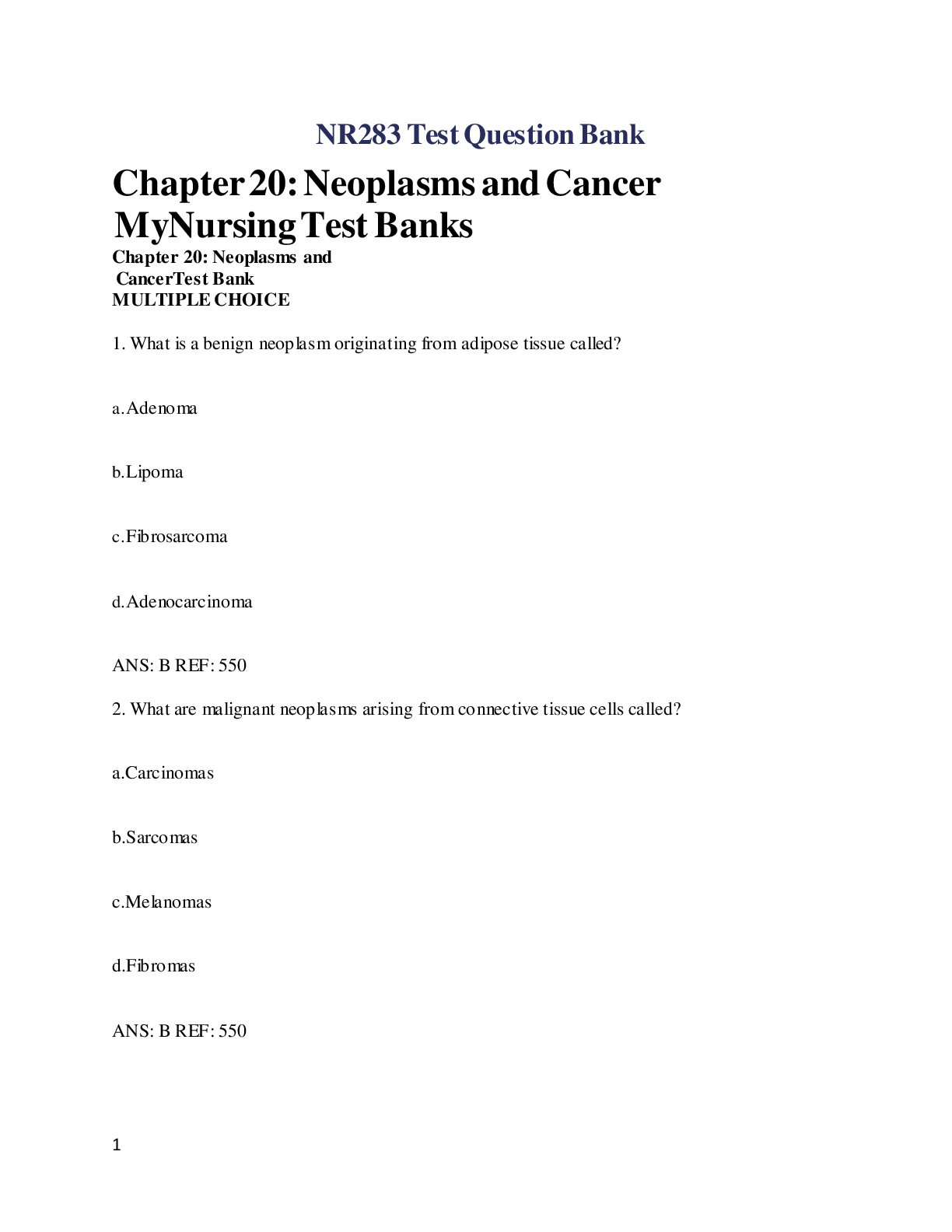

.png)
